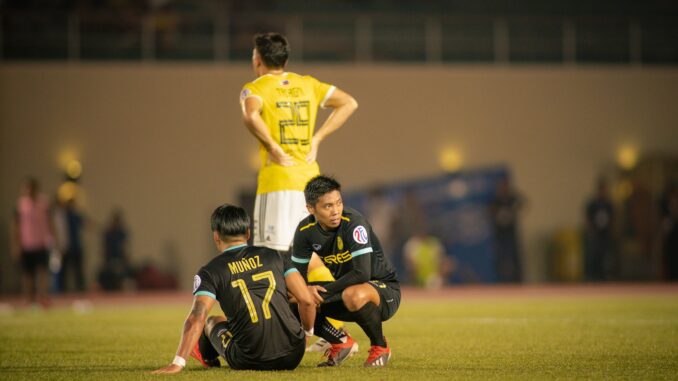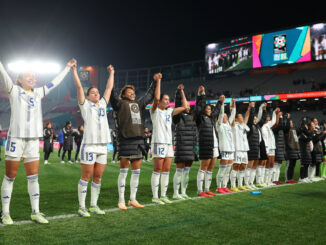
It may be very difficult to imagine it now, but there was actually a time when Filipinos came out in numbers to watch a domestic league football match in Manila.
Rival sets of fans would tout banners and cheer on their heroes, spending hard-earned money to make their way to the stadium.
Today, mostly empty bleachers and a general apathy towards the sport begs the question: what happened?
Despite lagging significantly behind other sports in popularity in the Philippines, football was thrust into the limelight after the men’s National Team, commonly known as the Azkals, stormed their way through to the semi-finals of the 2010 Suzuki Cup.
Filipinos rediscovered their love for the beautiful game after that most improbable run, and what followed was a period of glorious renaissance for the oft over-looked sport in the country.
With the national spotlight on them, the erstwhile fledgling local league, the United Football League (UFL) came to the fore.
Barely given scant attention before 2010, the league was the recipient of a lucrative TV deal worth 150 million pesos ($3m USD) for five years, giving the league a massive boost financially.
Using both on-field footballing talents and good looks to equal measure, many footballers such as former Chelsea Youth players Phil and James Younghusband became household names.
Eager to catch on to the next big thing, fans trooped to the stadium as the league – and the sport – came to life.
Live TV coverage was the norm, with four games being shown live on a leading TV network on the weekend. Once relegated to weekend corporate matches and one day football festivals, local Philippine football was back.
At its peak in 2013, there were ten teams in the both the first and second divisions, with a promotion and relegation setup in place. Unfortunately, that was as good as it got, and things would go downhill from there on in.
In 2012 and 2014, the Azkals were favorites to reach the Suzuki Cup final. However on both occasions, a combination of poor preparation, general inexperience, and bad luck would see the Azkals get knocked out in the semi-finals.
Would the sport have had a second renaissance had the Azkals won the Suzuki Cup? Certainly a new injection of interest, money, and sponsors would have been on the cards.
There would be minor victories along the way, but with the Azkals inability to capture the Suzuki Cup or the AFC Challenge Cup, which would have given the country its first ever Asian Cup appearance, football gradually lost its luster and appeal.
Coinciding with this decline in popularity was the termination of the five-year TV deal in 2016.
By then, the UFL were down to a single division of twelve teams, three of which would withdraw mid-season.
Attendances were primarily composed of friends and family, and in some games the TV crew filming the delayed telecast of the game would outnumber the other people in the grandstand.
Thus, there wasn’t a massive outpouring of grief when the UFL made way for a nationwide league, even getting partially involved in the conceptualisation and planning of the country-wide Philippines Football League.
The Philippines Football League (PFL), boasting of eight teams from all over the Philippines, was to be the answer to lift Philippine football out of its doldrums.
While the UFL held games primarily in one central venue, the PFL will feature home and away matches with previously untapped places like Ilocos, Davao, and Laguna, to be used.
Critics were quick to point out the monumental expenses of traveling the whole length and breadth of the Philippines with no evident plan to make back the money.
On top of that, a substantial ‘cost of participation’, with stringent conditions such as lockouts on potential sponsors, was reportedly set by the PFL, which turned off some UFL clubs.
Green Archers United, one of the pioneer members of the UFL, decided against joining the new PFL.
“We could not see how any club could grow given the conditions (given),” said team owner Ramon Garcia. “A club is a business, and without a sustainable business model it is doomed to fail.”
But, for a few glorious years, the PFL attracted home fans who packed the stadium in numbers.
It was a case of ‘build it and they will come.’ And from Davao to Bacolod to Ilocos, local football fans got to watch top quality football action in their doorstep.
Sustainability was the only problem.
True enough, the home and away concept was ditched only after two years, and the league, opted for a smaller but ultimately more sustainable system where games were to be played in one central venue, much like what the UFL did.
But with costs substantially lower, teams still continued to fold, with Ilocos United, Meralco Manila, Davao Aguilas and now Ceres Negros biting the proverbial dust.
Observers highlighted the dangers of having a single entity owning the team, with the team in danger should the single principal withdraw. Defending champions Ceres Negros is a perfect case in point.
Despite dominating the local football scene and winning the AFC Cup ASEAN Zonal Championships in 2017, team owner Leo Rey Yanson was forced to give up his beloved Ceres Negros team, with a family dispute and COVID-19 wreaking havoc on his business empire.
The team now has new owners and has rebranded into United City Football Club, with most key players retained.
The new owners have come out with the right words, stating that they will make it sure that the club will not be dependent on one entity for survival, as was the case for Ceres.
There are, however, examples of teams who have thrived under this model.
Despite being bankrolled by one of the country’s leading businessmen, Kaya FC resisted the urge to spend big, instead always insisting on spending wisely and prudently.
While it meant that throughout the years a lot of their star players have been poached by other clubs, financial prudence has meant that the club is healthy and well.
Participation in the AFC Cup in three of the last five years is proof enough of the club’s success.
Their youth system, headed by former Kaya coach and Azkals legend Chris Greatwich, is also thriving, providing the club with a potential pipeline of quality players without needing to spend big to buy.
While other teams try to outspend each other, newly-formed Maharlika FC, composed of former Azkal greats Anton del Rosario and Misagh Bahadoran, has taken the opposite route.
In true personification of the mantra ‘for the love of the game’, all members of Maharlika FC will not be receiving salaries initially, but are playing ‘for the love and the passion of the sport’.
While it will be folly to expect all players to play for free, the days of clubs relying on a single benefactor to fund the team might be a thing of the past, at least in Philippine football.
“No club can survive for long without a sustainable value-based model,” explains Archers’ Garcia.
“Clubs that can’t provide relative value to their stakeholders, like the fans, players, owners, sponsors, community are only short-term ego projects.”
Stallion, Mendiola and guest team Azkals Development Team join United City, Kaya and Maharlika to comprise the six team Philippines Football League, with the champions getting an automatic slot to the AFC Champions League and the runners up going into the playoffs.
With fans still not allowed to attend matches due to the pandemic, this year’s central venue, the National Team Training Center in Carmona, Cavite, roughly 37 kilometers from the Makati Business District and largely inaccessible by public transport, will fit the purpose.
But when fans are allowed back, accessibility has to be a big priority in considering future venues.
With Qatar Airways on board on a three- year deal, this could be a landmark year for Philippine club football to rise again, pandemic be damned.
With minimal interest from the traditional TV networks, going digital via YouTube to show the games live could be the way to go.
Not only will the money from new sponsors Qatar Airways be better spent, nearly everyone nowadays will have a smartphone in their hands. It will now be down to encouraging them to tune in.
To grow the game, the youth will be key.
Before the pandemic, a glance at any weekend youth football tournament will show a healthy attendance of excited kids and parents.
If properly harnessed, these aspiring kids could well provide a pipeline for providing players for the domestic clubs, as Kaya has shown some years back.
To say that all the gains and political capital from that magical 2010 Suzuki Cup run have been wasted may be a bit of an exaggeration, but they may not be too far from the truth.
It is true that more young children are taking up the sport, and are joining youth tournaments.
There is a general awareness and acknowledgement of the sport’s existence in the country and the Azkals are fairly recognized in the country.
But the general feeling is that had the stakeholders got their act together and done it right, football could have been much bigger than it is now.
Yet, as always, hope spring eternal. Philippines football survived having no venue to host a historic first ever Suzuki Cup semi-final; it can survive a global pandemic and a six-team domestic league.
Despite rising COVID-19 cases, training is underway for the 2020 PFL season. And with one-third of the teams guaranteed to see continental action next year, the fight for the top two spots will be intense.
We just hope enough fans care enough to see them play and make Philippine football relevant again.
It’s too good not to be.
Photo: Philippines Football League




